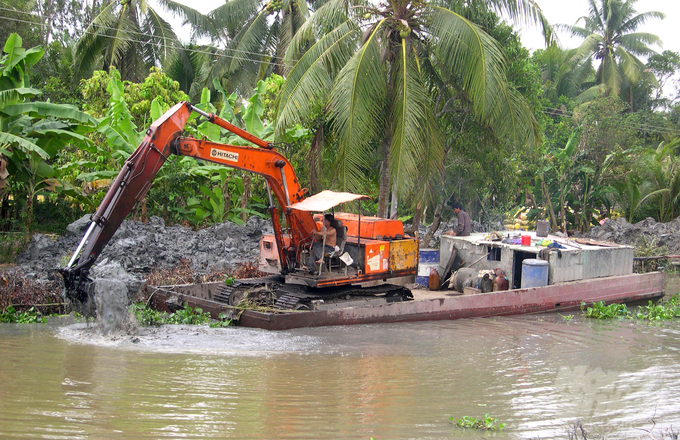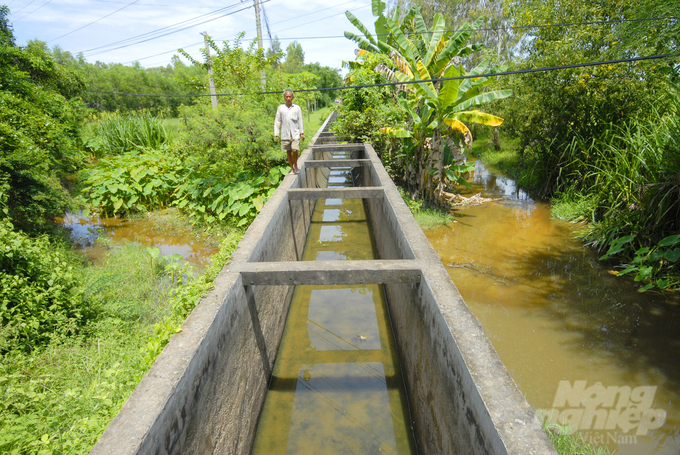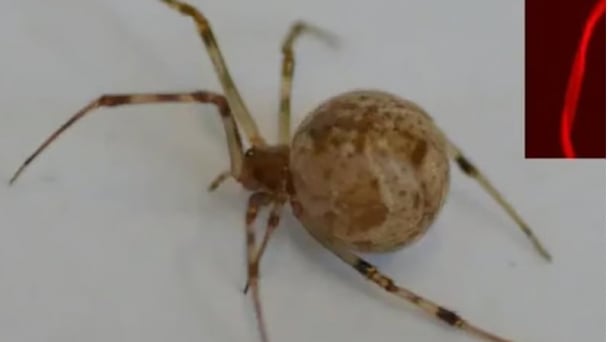May 21, 2025 | 19:18 GMT +7
May 21, 2025 | 19:18 GMT +7
Hotline: 0913.378.918
May 21, 2025 | 19:18 GMT +7
Hotline: 0913.378.918

An Giang province is actively implementing irrigation projects. Photo: Le Hoang Vu.
Local governments in An Giang province are currently initiating the construction of various irrigation works in the dry season to support agricultural production for the 2023 summer-autumn crop. In addition to investment capital from the state budget, local governments are encouraging its people to cooperate.
Although An Giang province recently entered the dry season, there are no signs of drought, and there is sufficient water for agricultural production. However, local governments are actively implementing irrigation projects in order to maintain uninterrupted agricultural production for the summer-autumn crop as well as prepare for adverse weather conditions,
Accordingly, local governments have focused on mobilizing resources and prioritize allocating capital to carry out in-field irrigation, ensuring water supply in dry weather and draining water when inundated. Local governments will deploy various dry season irrigation projects after the harvest of the 2023 winter-spring rice crop.
Mr. Nguyen Van Van, Head of Tri Ton district's Department of Agriculture and Rural Development, Tri Ton district said, "As a a mountainous district, Tri Ton district has the largest natural area in An Giang province with over 60,000 hectares of land area, including over 45,000 hectares of rice production area. Due to a lack of investment in the local irrigation system, agricultural production in Tri Ton district has been less effective compared to other localities in the province".
In recent years, An Giang province has invested in multiple irrigation projects in the delta and mountainous areas in Tri Ton district. As a result, the local irrigation system has been upgraded to support agricultural production in both the dry and rainy seasons.

Thanks to investment in irrigation projects, farmers earned additional income from agricultural production. Photo: Le Hoang Vu.
According to Mr. Van, the well-maintained infield irrigation system, approximately 24,000 hectares of land in the dike areas has been fully irrigated. For open dike areas and ineffective rice production land, the irrigation system has gradually improved the yield of rice. Additionally, a portion of the ineffective rice production land will be converted to tissue-transplanted bananas production.
According to Mr. Luong Huy Khanh, Director of An Giang Sub-Department of Irrigation, An Giang province sowed 230,000 hectares of rice during the 2023 summer-autumn crop, which is 100% of the province's total area.An Giang's agricultural sector anticipates a highly productive and profitable summer-autumn rice crop.
As a result, farmers need to promote the application of mechanization and technical advances in agricultural production to reduce labor costs and improve efficiency. Most importantly, the in-field irrigation system have contributed greatly to the irrigation of the summer-autumn rice crop.
An Giang province invested in deploying 327 projects that involve dredging canals, reinforcing dikes, repairing culverts, and pumping stations to support agricultural production and local people's livelihood. The total capital of these projects reached over 218 billion VND. Accordingly, 115 canals were dredge, 144 dikes were reinforced, and 68 culverts were repaired and maintained.

An Giang province aims to further enhance its irrigation system to support local agricultural production more effectively. Photo: Le Hoang Vu.
Mr. Khanh contended that protecting rice land and increasing irrigation system investment should be prioritized so that the local irrigation system can support agricultural production more effectively. Furthermore, the local government needs to invest in converting from rice to other crops of higher economic value.
In addition, the irrigation system in the crop production area needs to be promptly completed. Some future projects to be considered include: an investment project in upland water reservoirs to support agricultural production and climate change adaptation in Tri Ton district, Tinh Bien town; a project for "Modernization of irrigation systems to support shifting sustainable agricultural conversion and development in An Giang province”.
The government of An Giang province needs to fully utilize various ODA capital sources to develop irrigation infrastructure. Namely, it should focus on investing in production area along with livelihood models, and climate change adaptation, emphasize Mr. Luong Huy Khanh.
On the other hand, despite the rainy season, the water level in various dams across the country has not increased, which signals a potentially severe El Nino in the immediate future. As a result, local governments have proposed multiple countermeasures in response to this impending threat.
Translated by Nguyen Hai Long

(VAN) At the conference to disseminate Resolution No. 68, AgriS introduced its digital agricultural ecosystem and reaffirmed its commitment to accompanying the Government in promoting private sector development and sustainable agriculture.

(VAN) 'Blue Ocean - Blue Foods' initiative is designed to restore marine ecosystems and establish sustainable livelihoods for local communities by cultivating a minimum of 1,000 hectares of cottonii seaweed in the first three years.
/2025/05/21/4642-3-112707_603.jpg)
(VAN) The V-SCOPE project has made direct contributions to three out of six pillars of the Comprehensive Strategic Partnership between Vietnam and Australia.

(VAN) Facing the threat of rabies spreading to the community, Gia Lai province urgently carries out measures to vaccinate dogs and cats on a large scale.

(VAN) Disease-free livestock farming not only protects livestock herds but also stabilizes production and livelihoods for many farmers in Tuyen Quang.

(VAN) Japan's grant aid project contributes to capacity building, promoting organic agricultural production, and fostering sustainable community development in Dong Thap province.

(VAN) For years, the CRISPR-Cas9 genome technology has been reshaping genetic engineering, a precision tool to transform everything from agriculture to medicine.